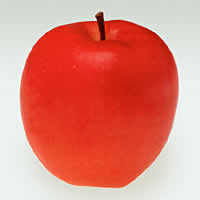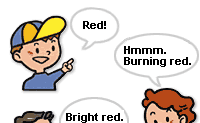Precise Color Communication
 |
   |
Color is a matter of perception and subjective interpretation. Even if they are looking at the same object (in this case, an apple), people will draw upon different references and experiences and express the exact same color in vastly different words. Because there is such a wide variety of ways to express a color, describing a particular color to someone is extremely difficult and vague. If we describe the color of the apple to someone as "burning red", can we expect them to be able to reproduce that color exactly? Verbal expression of color is too complicated and difficult. However, if there was a standard method by which colors could be accurately expressed and understood by anyone, color communication would be much smoother, simpler, and exact. Such precise color communication would eliminate color-related problems.
Words for expressing colors have always changed with the times. If we consider, for instance, the red we've been talking about, there are "vermillion", "cinnabar", "crimson", "rose", "strawberry", and "scarlet", to mention just a few. These are called common color names.
By analyzing the color condition and adding adjectives such as "bright", "dull", and "deep", we can describe the color a little more precisely. Terms such as the "bright red" used by the man on the facing page are called systematic color names. Although there are a variety of such ways to describe color, different people hearing just "crimson" or "bright red" will still interpret such expressions in different ways. So verbal expression of colors is still not accurate enough. Then how should colors be expressed to avoid the possibility of misunderstanding? |
| 1/13 | ||
|
|

